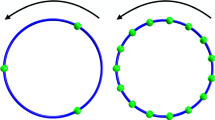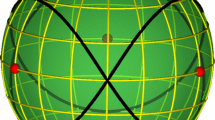Abstract
We use numerical continuation and bifurcation techniques in a boundary value setting to follow Lyapunov families of periodic orbits and subsequently bifurcating families. The Lyapunov families arise from the polygonal equilibrium of n bodies in a rotating frame of reference. When the frequency of a Lyapunov orbit and the frequency of the rotating frame have a rational relationship, then the orbit is also periodic in the inertial frame. We prove that a dense set of Lyapunov orbits, with frequencies satisfying a diophantine equation, correspond to choreographies. We present a sample of the many choreographies that we have determined numerically along the Lyapunov families and along bifurcating families, namely for the cases \(n=3\), 4, and 6–9. We also present numerical results for the case where there is a central body that affects the choreography, but that does not participate in it. Animations of the families and the choreographies can be seen at the link below.











Similar content being viewed by others
Notes
We say that \(q\prime \) is the n-modular inverse of q if \(q\prime q\) is congruent to 1 modulus n.
References
Alexander, J., Yorke, J.: Global bifurcations of periodic orbits. Am. J. Math. 100, 263–292 (1978)
Barrabés, E., Cors, J.M., Pinyol, C., Soler, J.: Hip-hop solutions of the \(2n\)-body problem. Celest. Mech. Dyn. Astronom. 95(1–4), 55–66 (2006)
Barutello, V., Terracini, S.: Action minimizing orbits in the \(n\)-body problem with simple choreography constraint. Nonlinearity 17, 2015–2039 (2004)
Barutello, V., Ferrario, D., Terracini, S.: Symmetry groups of the planar 3-body problem and action-mimizing trajectories. Arch. Ration. Mech. Anal. 190, 189–226 (2008)
Calleja, R., Doedel, E., García-Azpeitia, C.: Symmetry-breaking for a restricted \(n\)-body problem in the Maxwell-ring configuration. Eur. Phys. J. ST 225, 2741–2750 (2016)
Chen, K.-C.: Binary decompositions for planar n-body problems and symmetric periodic solutions. Arch. Ration. Mech. Anal. 170, 247–276 (2003)
Chenciner, A., Féjoz, J.: Unchained polygons and the \(n\)-body problem. Regul. Chaotic Dyn. 14(1), 64–115 (2009)
Chenciner, A., Montgomery, R.: A remarkable periodic solution of the three-body problem in the case of equal masses. Ann. Math. 152(2), 881–901 (2000)
Chenciner, A., Gerver, J., Montgomery, R., Simó, C.: Simple choreographic motions of N bodies A preliminary study. In: Marsden, J.E., Newton, P., Holmes, P., Weinstein, A. (eds.) Geometry, Mechanics, and Dynamics, 60th birthday of J. E. Marsden. Springer, New York (2002)
Chenciner, A., Féjoz, J., Montgomery, R.: Rotating eights I: the three \(\Gamma_{i}\) families. Nonlinearity 18, 1407–1424 (2005)
Doedel, E., Freire, E., Galán, J., Muñoz-Almaraz, F., Vanderbauwhede, A.: Stability and bifurcations of the figure-8 solution of the three-body problem. Phys. Rev. Lett. 88, 241101 (2002)
Ferrario, D.: Symmetry groups and non-planar collisionless action-minimizing solutions of the three-body problem in three-dimensional space. Arch. Ration. Mech. Anal. 179(3), 389–412 (2006)
Ferrario, D., Portaluri, A.: On the dihedral \(n\)-body problem. Nonlinearity 21(6), 1307–1321 (2008)
Ferrario, D., Terracini, S.: On the existence of collisionless equivariant minimizers for the classical \(n\)-body problem. Invent. Math. 155(2), 305–362 (2004)
García-Azpeitia, C., Ize, J.: Global bifurcation of polygonal relative equilibria for masses, vortices and dNLS oscillators. J. Differ. Equ. 251, 3202–3227 (2011)
García-Azpeitia, C., Ize, J.: Global bifurcation of planar and spatial periodic solutions in the restricted n-body problem. Celest. Mech. Dyn. Astron. 110, 217–227 (2011)
García-Azpeitia, C., Ize, J.: Global bifurcation of planar and spatial periodic solutions from the polygonal relative equilibria for the \(n\)-body problem. J. Differ. Equ. 254, 2033–2075 (2013)
Ize, J., Vignoli, A.: Equivariant Degree Theory. De Gruyter Series in Nonlinear Analysis and Applications 8. Walter de Gruyter, Berlin (2003)
Kapela, T., Simó, C.: Rigorous KAM results around arbitrary periodic orbits for Hamiltonian Systems. Preprint (2017)
Kapela, T., Simó, C.: Computer assisted proofs for nonsymmetric planar choreographies and for stability of the Eight. Nonlinearity 20, 1241–1255 (2007)
Kapela, T., Zgliczynski, P.: An existence of simple choreographies for \(N\)-body problem: a computer assisted proof. Nonlinearity 16, 1899–1918 (2003)
Marchal, C.: The family P12 of the three-body problem. The simplest family of periodic orbits with twelve symmetries per period. Celest. Mech. Dyn. Astron. 78, 279–298 (2000)
Marchal, C.: How the method of minimization of action avoids singularities. Celest. Mech. Dyn. Astron. 83, 325–353 (2002)
Meyer, K., Schmidt, D.: Librations of central configurations and braided saturn rings. Celest. Mech. Dyn. Astron. 55(3), 289–303 (1993)
Moeckel, R.: Linear stability of relative equilibria with a dominant mass. J. Dyn. Differ. Equ. 6, 37–51 (1994)
Montaldi, J., Steckles, K.: Classification of symmetry groups for planar n-body choreographies. Forum of Mathematics, Sigma 1 (2013)
Moore, C.: Braids in classical gravity. Phys. Rev. Lett. 70, 3675–3679 (1993)
Muñoz-Almaraz, F., Freire, E., Galán, J., Doedel, E., Vanderbauwhede, A.: Continuation of periodic orbits in conservative and Hamiltonian systems. Phys. D 181, 1–38 (2003)
Roberts, G.E.: Linear stability in the \(1+n\)-non relative equilibrium. In: Delgado, J. (ed), Hamiltonian Systems and Celestial Mechanics. HAMSYS-98. Proceedings of the 3rd International Symposium, World Sci. Monogr. Ser. Math. 6. World Scientific, pp. 303–330 (2000)
Simó, C.: New families of solutions in N-body problems. In: European Congress of Mathematics. Springer Nature, pp. 101–115 (2001)
Terracini, S., Venturelli, A.: Symmetric trajectories for the \(2n\)-body problem with equal masses. Arch. Ration. Mech. Anal. 184(3), 465–493 (2007)
Vanderbei, R., Kolemen, E.: Linear stability of ring systems. Astron. J. 133, 656–664 (2007)
Acknowledgements
We thank R. Montgomery, J. Montaldi, D. Ayala, and L. García-Naranjo for many interesting discussions. We also acknowledge the assistance of Ramiro Chavez Tovar with the preparation of figures and animations. This research was also supported by NSERC (Canada) Grant N00138. R. C. was partially supported by PAPIIT Project IA102818.
Author information
Authors and Affiliations
Corresponding author
Additional information
Rights and permissions
About this article
Cite this article
Calleja, R., Doedel, E. & García-Azpeitia, C. Symmetries and choreographies in families that bifurcate from the polygonal relative equilibrium of the n-body problem. Celest Mech Dyn Astr 130, 48 (2018). https://doi.org/10.1007/s10569-018-9841-9
Received:
Revised:
Accepted:
Published:
DOI: https://doi.org/10.1007/s10569-018-9841-9




